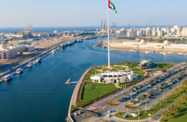Increased public investment and a recovery in demand across the region helped Sharjah post more robust growth in 2019, as the emirate continues to expand its free zones and industrial projects.

In an economic forecast released in late October, credit ratings agency Standard & Poor’s (S&P) said Sharjah’s economy was expected to expand by 2.3% over the course of the year, considerably higher than 2018’s rate of 0.7%.
This outlook aligns with the UAE central bank’s full-year forecast of 2.4% for the whole country, and is higher than the IMF’s national projection of 1.6%.
See also: The Report – Sharjah 2018
Primary growth drivers
Increased public expenditure is a key factor behind the spike in the emirate’s growth levels, with government income rising on the back of the UAE-wide rollout of a 5% value-added tax in 2018.
With 23% of the annual budget – which was up 10% on 2018 – dedicated to infrastructure development, the emirate was able to achieve progress on a number of projects.
For example, in mid-November officials announced the completion of a Dh28m ($7.6m) road project. Located in the emirate’s central region, the 8.2-km link is designed to improve mobility between industrial zones in Al Batayeh, Al Dhaid, Al Madam and Mleiha.
Investments related to Dubai Expo 2020 and Abu Dhabi’s new economic stimulus plan have also had a positive knock-on effect on Sharjah’s economy.
Notwithstanding these developments, however, some commentators have expressed concerns that a full economic recovery may still be some way off. Key ongoing challenges include excessive red tape and the slow uptake of digitalisation.
Diversification continues
As one of the most diversified of the emirates within the UAE, Sharjah is far less reliant on hydrocarbons than many of its neighbours.
Indeed, around 92% of its GDP is derived from non-oil sectors, with industry (25%), wholesale and retail (11.6%), real estate (10.4%) and construction (7.7%) the main economic drivers.
To further expand its industrial capacity, which is largely connected to a series of free zones, the emirate’s investment arm Sharjah Asset Management launched the Al Saja’a Industrial Village project in October.
The development consists of 100 units of showrooms, warehouses and open spaces for industrial or commercial investors, and is expected to help drive growth in logistics, technology, industry, transportation, and oil and gas.
Meanwhile, in a bid to boost the emirate’s media industry, in November the authorities announced the establishment of Access Sharjah, a body designed to develop media start-ups and connect them with potential clients and stakeholders in the Sharjah Publishing City Free Zone.
The initiative, set to launch in March 2020, features a series of workshops and training sessions for promising start-ups, free office space for new businesses and a $100,000 fund to help support successful entrepreneurs.
Real estate spike
The real estate market is another sector that saw expansion throughout 2019.
Total transactions reached Dh18.9bn ($5.1bn) in the first nine months of the year, up 29.5% year-on-year on the Dh14.6bn ($4bn) recorded during the same period in 2018.
Residential purchases accounted for around 65% of sales, with developer Savills noting that Sharjah’s growing population was driving demand in a series of areas outside of Sharjah City.
To help meet this demand, in December the government approved the development of 4765 residential plots, to be spread around the emirate.
Elsewhere, in May and September Sharjah-based real estate developer Arada signed off on the first and second phases, respectively, of its Nasma Residences project.
The five-stage, $408m development, located in the Al Tay district, will consist of 958 residential units once fully completed by the end of 2020.
Progress has also been made on the 24m-sq-feet Al Jada mixed-use community. Construction work began in April 2018 and Arada is expected to hand over its first homes in the first quarter of 2020.
Looking ahead, a robust construction pipeline, along with the expansion of industrial capacity and free zones, remain key to attracting foreign direct investment and ensuring sustainable growth, with S&P projecting GDP growth in the emirate will accelerate to 2.5% in 2020 before settling at an average of 2% through to 2022.


